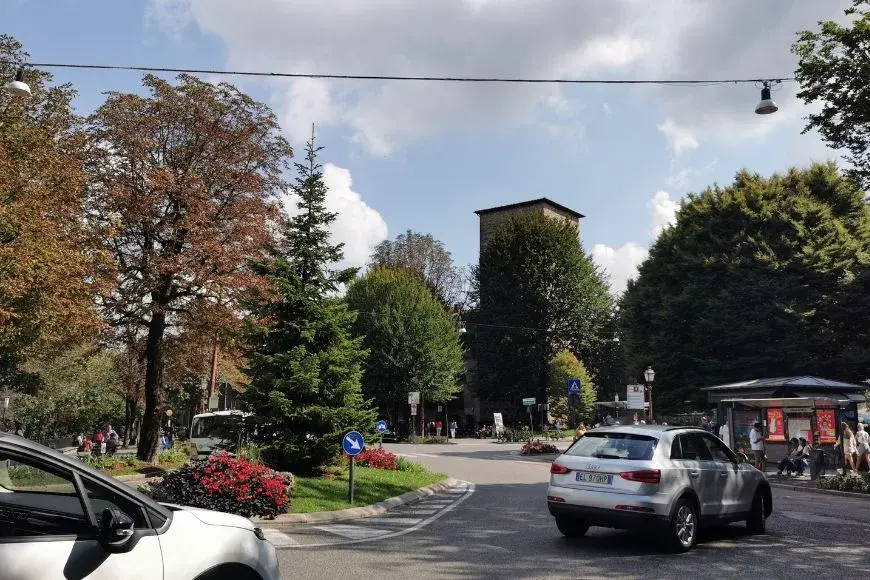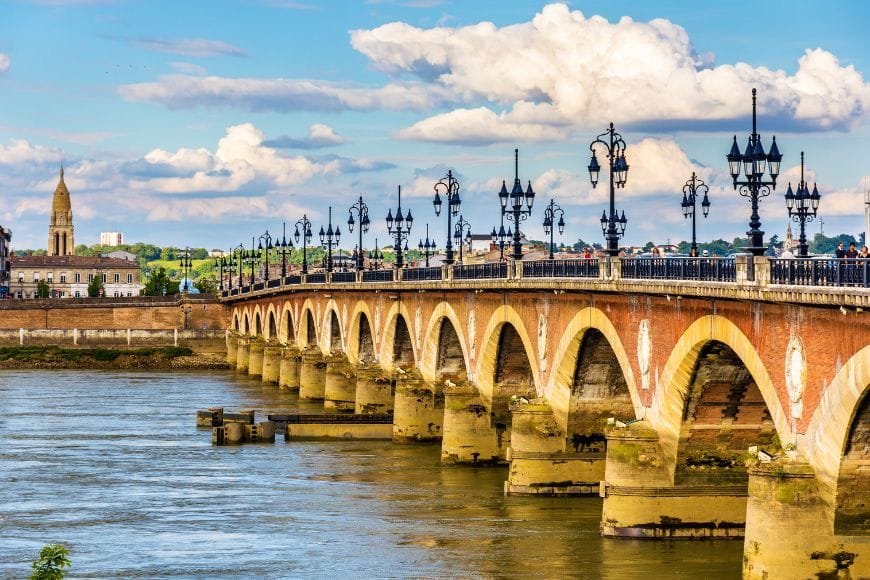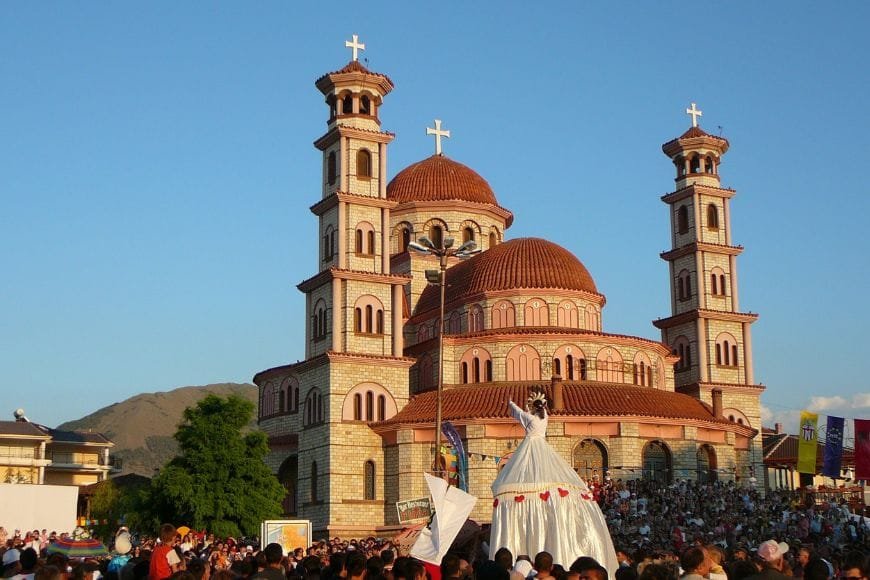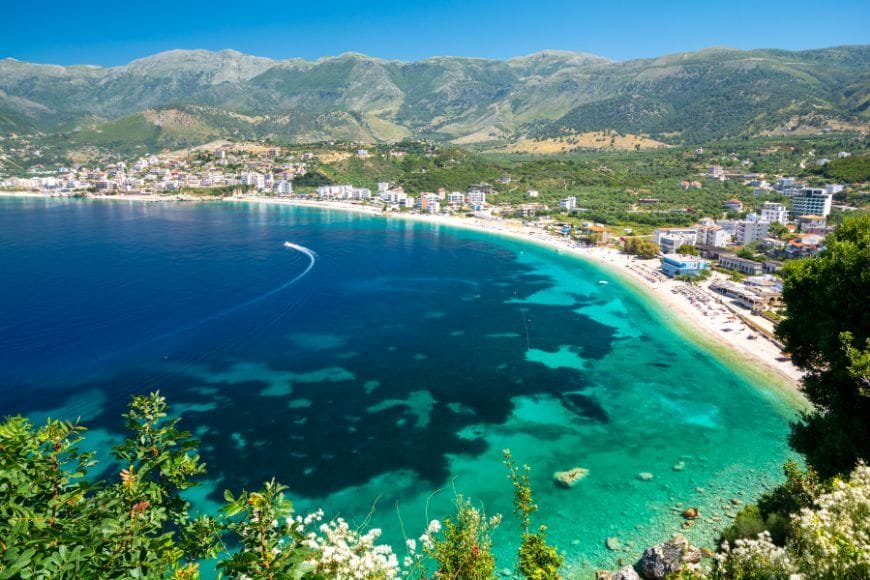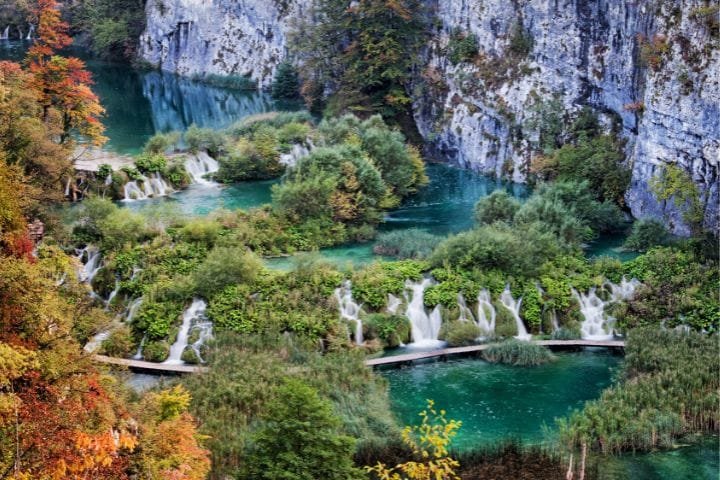10-Day Croatia Road Trip Itinerary from Zagreb to Dubrovnik (2025 Guide)

by Hwan | Last Updated December 4, 2025

Ready to embark on one of Europe’s most spectacular road trip adventures through a country that combines medieval cities, pristine national parks, crystal-clear Adriatic waters, and over 1,000 islands into an unforgettable journey?
After completing multiple Croatia road trips over the past eight years – from extended month-long explorations to focused 10-day adventures – I can tell you that the route from Zagreb to Dubrovnik showcases the incredible diversity that makes Croatia one of Europe’s premier road trip destinations.
This carefully crafted 10-day itinerary balances must-see highlights with hidden gems, combining the cultural richness of Zagreb and the medieval charm of coastal cities with the natural wonder of Plitvice Lakes, the vibrant energy of Split, and the stunning beauty of Croatia’s islands and coastline.
Whether you’re seeking adventure in national parks with cascading waterfalls and pristine lakes, cultural discoveries in UNESCO World Heritage cities, relaxation on some of Europe’s most beautiful beaches, or authentic experiences in traditional villages, this road trip delivers experiences that satisfy every type of traveler while showcasing why Croatia has become one of Europe’s hottest destinations.
Let me share with you the best 10-day Croatia road trip itinerary that will make your vacation truly extraordinary!
Day 1-2: Zagreb – Croatian Capital and Cultural Gateway

Historic Upper Town reveals Zagreb’s medieval origins through cobblestone streets, Baroque architecture, and panoramic city views, providing a perfect introduction to Croatian culture and history. The funicular connecting Upper and Lower Towns, which has been operating since 1893, offers both transportation and a historical experience.
Start your Croatian adventure at Tkalčićeva Street, Zagreb’s pedestrian heart, where locals gather for coffee and conversation. This vibrant strip showcases modern Croatian life while maintaining an authentic atmosphere that helps visitors understand contemporary Croatian culture.
Vibrant Lower Town showcases Austro-Hungarian grandeur with impressive architecture, cultural institutions, and the famous Dolac Market where locals shop for fresh produce, traditional crafts, and regional specialties that introduce Croatian culinary traditions.
The Croatian National Theatre and Zagreb Cathedral provide cultural and religious insights, while nearby cafés offer opportunities to experience Croatian coffee culture and observe daily life rhythms that define this sophisticated capital city.
Local food scene combines traditional and contemporary influences, reflecting Croatia’s position between Central European and Mediterranean cultures. Traditional dishes like štrukli (cheese pastry) and čevapi represent authentic Croatian comfort food.
I recommend dining at Vinodol for upscale traditional cuisine or exploring the numerous wine bars that showcase Croatia’s emerging wine regions – the country’s wine culture has exploded in recent years and produces some exceptional varieties.
Day trip options from Zagreb include charming Samobor (30 minutes), famous for its kremšnita (cream cake) and traditional architecture, or countryside excursions to castles like Trakošćan that showcase Croatia’s noble heritage.
Zagreb accommodation and driving tips:
- Stay in Upper Town for historic atmosphere or Lower Town for modern convenience
- Zagreb has excellent public transportation, reducing the need for city driving
- Secure parking essential – many hotels offer garage facilities
- Airport rental car pickup is recommended to avoid city center driving
- Allow extra time for orientation and getting comfortable with Croatian road signs
🧭 Plan Smart Before You Hit the Road
Make sure your logistics are set for toll roads, borders & weather changes along Croatia’s coast.
- How to Plan a Balkan Road Trip in 2025: Routes, Tips & Must-See Stops — Everything you need before finalizing your itinerary.
- Balkan Toll Roads Guide 2025 — Croatia uses toll booths — here’s what to expect.
- Balkan Road Trip Border Crossings: Complete 2025 Guide — Required documents if extending into Montenegro or Bosnia.
Day 3: Zagreb to Plitvice Lakes National Park

My first Croatia road trip was honestly overwhelming – I had no idea how much stunning scenery and cultural richness were packed into this relatively small country. From the moment I drove through the rolling hills approaching Plitvice Lakes to that first breathtaking view of Dubrovnik’s walls rising from the Adriatic, I knew I’d discovered something special.
Scenic driving route through Croatian countryside provides a gentle introduction to Croatia’s natural beauty with rolling hills, traditional villages, and glimpses of rural life that continue largely unchanged despite modern development.
The 2-hour drive from Zagreb passes through Karlovac and the Lika region, showcasing agricultural landscapes and traditional architecture that provide cultural context for understanding Croatia beyond its famous coastline.
Plitvice Lakes entrance strategies require advance online booking, especially during summer months when daily visitor numbers are limited to protect this UNESCO World Heritage site. Early morning or late afternoon visits provide better lighting and fewer crowds.
The park’s two main sections – Upper and Lower Lakes – offer different experiences. Lower Lakes feature the famous waterfalls and wooden walkways, while Upper Lakes provide more wilderness hiking and pristine lake views.
Trail recommendations depend on time and fitness levels. The basic Circuit A takes 2-3 hours and covers essential highlights, while Circuit H provides a comprehensive 6-8 hour experience including boat rides and train transportation within the park.
I always recommend starting with Lower Lakes early in the morning when lighting creates spectacular waterfall photography and crowds remain manageable. The wooden walkways can become congested later in the day.
Photography tips for optimal results include bringing polarizing filters to reduce water glare, waterproof camera protection for mist near waterfalls, and patience for capturing images without crowds of other visitors.
Accommodation near Plitvice Lakes:
- Book well in advance as options are limited near the park
- Hotel Jezero offers convenient park access but basic amenities
- Private guesthouses provide an authentic experience with local families
- Camping options available for adventure travelers
- Consider staying in nearby Rastoke for watermills and additional natural beauty
Day 4: Plitvice Lakes to Zadar

Morning park exploration allows final appreciation of Plitvice’s natural wonder before departing for Croatia’s Adriatic coast. Early departure (by 11 AM) ensures arrival in Zadar with afternoon for exploration.
Coastal route introduction begins as you descend from mountains toward sea level, with the landscape transitioning from forests and lakes to Mediterranean vegetation and glimpses of Adriatic waters.
Zadar’s Roman ruins and modern attractions create a fascinating blend between ancient heritage and contemporary innovation. The Roman Forum, dating to the 1st century BC, provides historical context while modern installations showcase Croatian creativity.
Sea Organ and Greeting to the Sun experiences represent Zadar’s innovative approach to urban design. The Sea Organ creates music from wave action while Greeting to the Sun provides spectacular light displays powered by solar energy.
These installations, designed by architect Nikola Bašić, demonstrate how contemporary design can enhance rather than compete with historic settings, creating experiences impossible to find elsewhere.
Historic old town wandering reveals layers of Croatian history through Roman, Byzantine, Venetian, and Austro-Hungarian influences reflected in architecture, street patterns, and cultural traditions that have evolved over two millennia.
Local dining recommendations include traditional konobas (taverns) serving fresh Adriatic seafood and regional specialties like pašticada (beef stew) and black risotto that showcase Dalmatian culinary heritage.
Zadar exploration highlights:
- Sea Organ sunset experience combining natural beauty with artistic innovation
- Roman Forum ruins providing historical context and photo opportunities
- St. Donatus Church showcasing Byzantine architecture and acoustics
- Traditional konoba dining featuring fresh Adriatic seafood
- Walking tours of the old town revealing layers of cultural heritage
Day 5: Zadar Area and Kornati Islands

Day trip to Kornati National Park provides access to Croatia’s most pristine marine environment with 89 islands creating dramatic seascapes that appear almost lunar in their stark beauty. Full-day boat excursions typically include swimming, snorkeling, and traditional lunch.
The Kornati islands represent Croatia at its most elemental – dramatic limestone formations rising from crystal-clear waters with minimal vegetation creating landscapes that feel almost otherworldly.
Alternative: Krka National Park waterfalls offer a different natural experience featuring accessible waterfalls where swimming is permitted (unlike Plitvice). Krka’s Skradinski Buk waterfall provides classic Croatia postcard scenery.
Zadar region hidden gems include traditional villages like Nin with its tiny cathedral and salt production, or Paklenica National Park for serious hiking with dramatic canyon scenery and rock climbing opportunities.
Local island culture and maritime traditions become visible through boat excursions that connect you with families who’ve lived from fishing and island agriculture for generations, maintaining traditions despite tourism pressures.
I particularly enjoy the boat trips that include stops at family-run restaurants on remote islands where you dine on fish caught that morning while learning about island life from people who’ve never lived anywhere else.
Evening coastal sunset experiences in Zadar are legendary – Alfred Hitchcock called Zadar sunsets the world’s most beautiful. The combination of Sea Organ music and Greeting to the Sun light show creates a magical evening atmosphere.
Island and region exploration options:
- Kornati National Park full-day boat excursion with swimming and dining
- Krka National Park waterfalls with swimming permissions
- Nin historic town with salt production and miniature cathedral
- Paklenica National Park for hiking and rock climbing adventures
- Traditional island restaurant experiences with local fishing families
Plan Your Trip with Our Favorite Booking Tools
Day 6-7: Split – Ancient Palace and Modern Vibrancy

Diocletian’s Palace exploration provides one of Europe’s most remarkable UNESCO World Heritage experiences, where ancient Roman architecture houses contemporary life. The palace isn’t a museum – it’s a living city where 3,000 people live within Roman walls.
Walking through the palace reveals how each historical period adapted existing structures for contemporary needs. Medieval churches occupy Roman temples, Renaissance palaces rise from Roman foundations, and modern shops operate within ancient walls.
Split’s beaches, markets, and vibrant nightlife create a perfect balance between cultural exploration and relaxation. Bačvice Beach offers city beach convenience while Marjan Hill provides hiking trails and panoramic views over the Adriatic.
The daily fish market demonstrates Split’s continuing connection to maritime traditions, while the evening promenade (called “špica”) showcases social customs that define Dalmatian coastal culture.
Day trip options include ferry rides to nearby islands that each offer distinct experiences. Hvar provides lavender fields and sophisticated nightlife, Brač features the famous Zlatni Rat beach, and Trogir offers another UNESCO site with an intimate medieval atmosphere.
I always recommend the Hvar day trip for first-time visitors – the 1-hour ferry ride provides beautiful coastal views, and Hvar town combines authentic Dalmatian architecture with contemporary sophistication and excellent dining.
Island ferry experiences introduce Croatia’s maritime culture while providing access to pristine beaches and traditional island communities. Ferry rides become scenic experiences rather than just transportation.
Traditional Dalmatian cuisine reaches high levels in Split with restaurants serving fresh seafood, locally-produced olive oil, and regional wines that showcase why Dalmatian cooking ranks among Mediterranean cuisine’s finest expressions.
Split exploration highlights:
- Diocletian’s Palace living history experience within Roman walls
- Daily fish market demonstrating continuing maritime traditions
- Island day trips revealing a diverse Croatian coastal culture
- Marjan Hill hiking with panoramic Adriatic views
- Traditional konoba dining featuring authentic Dalmatian specialties
Day 8: Split to Makarska Riviera

Scenic coastal highway driving (Magistrala) provides one of Europe’s most spectacular coastal routes with dramatic mountain-to-sea contrasts, traditional stone villages, and constant Adriatic views that make driving time pure pleasure.
The Magistrala highway winds along the coastline beneath Biokovo Mountain, creating dramatic scenery where pine forests meet crystal-clear waters and traditional fishing villages preserve authentic coastal culture.
Makarska and Riviera beach towns offer Croatia’s finest beach experiences with long pebble beaches, clear waters perfect for swimming, and traditional promenades where evening strolls reveal local social customs.
Makarska town provides sophisticated resort amenities while maintaining authentic Croatian character. The palm-lined promenade and traditional stone architecture create an outstanding Adriatic atmosphere.
Biokovo Nature Park mountain adventures provide a dramatic contrast to coastal experiences with hiking trails leading to viewpoints 1,762 meters above sea level, offering panoramic views of islands and coastline that seem to stretch forever.
The Skywalk viewing platform, extending from Biokovo’s cliffs, provides heart-stopping views and photo opportunities that showcase Croatia’s dramatic topographical diversity within short distances.
Traditional villages and authentic cultural experiences in Biokovo’s foothills preserve rural Croatian life where traditional crafts, agriculture, and customs continue largely unchanged despite coastal tourism development.
Coastal accommodation and sunset dining along Makarska Riviera offer a perfect combination of beach access, traditional cuisine, and spectacular evening views that define ideal Adriatic vacation experiences.
Makarska Riviera highlights:
- Magistrala coastal highway providing spectacular scenic driving
- Long pebble beaches with crystal-clear swimming conditions
- Biokovo Nature Park mountain hiking with panoramic viewpoints
- Traditional village visits preserving authentic rural culture
- Sunset dining overlooking Adriatic islands and coastline
Day 9: Makarska to Dubrovnik via Ston

Morning coastal drives continue spectacular Magistrala scenery with increasingly dramatic mountain-to-sea contrasts as you approach the Pelješac Peninsula and Croatia’s southernmost regions.
Ston’s medieval walls and oyster farms provide a fascinating combination of military history and culinary tradition. Ston’s 14th-century walls, Europe’s second-longest after China’s Great Wall, protected valuable salt production that continues today.
The oyster farms in Mali Ston Bay produce some of Europe’s finest oysters, cultivated in pristine waters where mountains meet sea. Oyster tasting here ranks among Croatia’s finest culinary experiences.
Pelješac Peninsula wine region produces Croatia’s most acclaimed red wines, particularly Plavac Mali varieties that thrive in the Mediterranean climate and limestone soils. Wine tasting stops provide perfect travel breaks while introducing Croatian wine culture.
Dramatic approach to Dubrovnik via coastal road provides first glimpses of this UNESCO city’s walls rising from Adriatic waters, creating one of Europe’s most spectacular urban vistas and a perfect introduction to your final destination.
Game of Thrones filming locations become visible as you approach Dubrovnik, where King’s Landing scenes transformed this medieval city into a global tourism phenomenon while somehow maintaining its authentic historical character.
Ston and Pelješac Peninsula highlights:
- Medieval walls protecting historic salt production facilities
- Oyster farm visits with fresh tastings in pristine bay waters
- Wine region exploration featuring Croatia’s finest red wine varieties
- Dramatic coastal scenery approaching Dubrovnik
- Game of Thrones filming location recognition and photo opportunities
Day 10: Dubrovnik – Pearl of the Adriatic

The Old Town walls walk provides an essential Dubrovnik experience with a 2-kilometer circuit offering panoramic views of red-tiled roofs, baroque churches, and crystal-clear Adriatic waters that justify this city’s “Pearl of the Adriatic” reputation.
Early morning wall walks (8 AM opening) provide optimal lighting, comfortable temperatures, and manageable crowds that allow proper appreciation of architectural details and scenic vistas.
Cable car rides to Mount Srđ offer spectacular panoramic views of Dubrovnik’s medieval walls, nearby islands, and Adriatic coastline stretching toward Montenegro. Sunset rides provide particularly magical experiences.
Historic old town exploration reveals architectural treasures, including Rector’s Palace, Sponza Palace, and Dominican Monastery that showcase Dubrovnik’s wealth and sophistication during its golden age as an independent republic.
The Stradun (main street) serves as an outdoor museum where every building represents a different historical period, while side streets reveal intimate squares and authentic local life continuing within medieval walls.
Lokrum Island day trip option provides a peaceful escape from old town crowds with botanical gardens, Fort Royal ruins, and clothing-optional beaches just 10 minutes by boat from Dubrovnik’s old port.
Final evening in a historic setting deserves celebration at one of Dubrovnik’s rooftop restaurants, where traditional Dalmatian cuisine combines with spectacular views of illuminated medieval walls and Adriatic waters.
Departure planning should account for Dubrovnik Airport’s distance (22km) from the city center and potential summer traffic delays that can extend transfer times significantly during peak tourist periods.
Dubrovnik essential experiences:
- City walls walk providing panoramic views and historical perspective
- Cable car rides offering spectacular aerial photography opportunities
- Historic palace and church visits revealing republican heritage
- Stradun promenade experience showcasing architectural evolution
- Sunset dining with views of illuminated medieval walls
Essential Croatia Road Trip Planning
Driving requirements include international driving permits for most visitors, though EU licenses are accepted. Croatian roads are generally excellent, but mountain and coastal routes require confident driving skills and proper vehicle insurance.
Tolls on major highways (autoceste) are reasonable and provide efficient travel between distant destinations. Highway rest stops offer clean facilities, good food, and fuel at competitive prices.
Road conditions vary from excellent highways to narrow coastal roads that require careful driving, especially during summer when traffic increases significantly. GPS navigation is reliable, but offline maps provide essential backup.
Best time to visit depends on priorities – summer offers warmest weather and all facilities open, but brings crowds and high prices. Shoulder seasons (May-June, September-October) provide an ideal balance of weather, availability, and value.
Accommodation booking strategies require advance planning, especially for coastal destinations during the summer months. Book 2-3 months ahead for July-August travel, earlier for popular islands and national park areas.
Ferry reservations for island visits should be made in advance during peak season. Walk-on passenger ferries rarely require reservations, but vehicle ferries can sell out during summer weekends.
Budget planning should account for seasonal variations, with summer prices 50-100% higher than shoulder seasons. Daily budgets can range from €75-150 per person, depending on accommodation choices and dining preferences.
Essential planning considerations:
- International driving permit and comprehensive vehicle insurance
- Advance accommodation booking for summer travel
- Ferry reservations for popular island destinations
- Flexible itinerary allowing weather and crowd adaptations
- Budget planning accounting for significant seasonal price variations
Hidden Gems and Alternative Routes

Off-the-beaten-path villages like Motovun in Istria, Rovinj’s old town, or Primošten’s traditional architecture provide authentic Croatian experiences away from major tourist flows while showcasing regional diversity and cultural traditions.
Scenic detours and photography opportunities include Biokovo Skywalk, Plitvice sunrise locations, Kornati island panoramas, and numerous coastal viewpoints that provide spectacular images and memorable experiences.
Local festivals and cultural events throughout Croatia showcase authentic traditions, local cuisine, and traditional music that provide cultural immersion impossible to experience through standard tourism activities.
Authentic dining experiences in family-run konobas, agritourism farms, and local markets offer genuine Croatian hospitality and cuisine using traditional recipes and locally-sourced ingredients.
Alternative itinerary options might include longer stays in fewer destinations, focus on specific regions like Istria or islands, or themed trips concentrating on national parks, wine regions, or cultural heritage sites.
Hidden gem discoveries:
- Traditional villages preserving authentic architecture and customs
- Local festivals showcasing regional culture and culinary traditions
- Family-run restaurants serving traditional recipes with local ingredients
- Scenic viewpoints providing spectacular photography opportunities
- Regional specializations allowing deeper cultural exploration
Plan Your Trip with Our Favorite Booking Tools
Creating Your Perfect Croatian Adventure
This 10-day Croatia road trip from Zagreb to Dubrovnik delivers the perfect introduction to a country that combines stunning natural beauty, rich historical heritage, and vibrant contemporary culture into one unforgettable journey.
The carefully planned route balances must-see destinations with authentic local experiences, providing comprehensive exposure to Croatia’s diverse landscapes, from mountain lakes and waterfalls to pristine coastlines and historic cities that preserve centuries of Mediterranean heritage.
Remember that Croatia’s popularity has grown dramatically, making advance planning essential for accommodation and ferry reservations, especially during the summer months when coastal destinations reach peak capacity. The magic of this road trip lies not just in the famous destinations, but in the spontaneous discoveries, scenic drives, and cultural encounters that occur when you have the freedom to explore at your own pace.
My approach to Croatian road trips has evolved to embrace both structured planning and spontaneous discovery. Having firm accommodation reservations provides security, while maintaining flexible daily schedules allows for those unexpected encounters and extended stays at places that capture your imagination.
Drive safely, plan flexibly, and prepare for an adventure that combines natural wonders, cultural treasures, and coastal beauty into memories that will inspire future returns to this remarkable country– welcome to one of Europe’s most spectacular road trip destinations!
🌄 Scenic Coastal Stops to Add to Your Route
These drives & views pair perfectly with a Zagreb–Dubrovnik journey.
FAQs on Croatia Road Trip Itinerary
What is the best time of year to follow a Croatia road trip itinerary?
The best months are May–June and September–October for great weather and fewer crowds.
Do I need an international driving permit for a Croatia road trip itinerary?
If your license isn’t in Roman script, an International Driving Permit is required. EU and U.S. licenses are generally accepted.
Can I do a Croatia road trip itinerary in reverse direction?
Yes, the itinerary can be done in either direction with the same major highlights.
Are one-way car rentals available for a Croatia road trip itinerary?
Yes, most rental companies allow one-way rentals within Croatia, though a drop-off fee may apply.
Does a Croatia road trip itinerary involve any border crossings?
Yes, if you drive along the coast, you’ll briefly pass through Bosnia and Herzegovina near Neum.
How much driving is involved in a typical Croatia road trip itinerary?
Expect to drive around 4–5 hours on travel days, depending on your route and stops.
What are the must-see stops on a Croatia road trip itinerary?
Popular stops include Plitvice Lakes, Zadar, Krka National Park, Split, Hvar or Korčula, and Ston.
Is parking difficult during a Croatia road trip itinerary?
Parking can be tricky in historic city centers; look for hotels with parking or use public lots nearby.
Can I bring a rental car on ferries during a Croatia road trip itinerary?
Yes, some ferries allow cars, but check with your rental company and book ferry tickets in advance.
Should I book accommodation in advance for a Croatia road trip itinerary?
In peak season (July–August), booking ahead is strongly recommended. In shoulder seasons, there’s more flexibility.
🌍 More Balkan Road Trips You’ll Love
Explore beyond Croatia and discover more incredible Balkan highlights.
- 14-Day Balkan Road Trip Itinerary 2025: Hidden Gems Route — Includes Croatia + neighboring countries.
- 7-Day Montenegro Road Trip Itinerary 2025 — A perfect pairing with Dubrovnik.
- Albania Road Trip Route 2025 — Expand your adventure beyond Croatia!
💬 We’d love to hear from you!
Have questions, tips, or personal travel stories to share? Drop them in the comments below — your insights help fellow travelers plan their adventures too.

